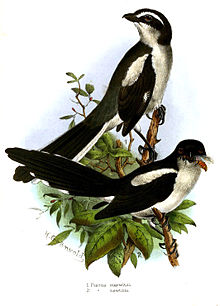Uhehe fiscal
| Uhehe fiscal | |
|---|---|

| |
| Illustration (above) with Lanius newtoni (lower bird) | |
| Scientific classification | |
| Kingdom: | Animalia |
| Phylum: | Chordata |
| Class: | Aves |
| Order: | Passeriformes |
| Family: | Laniidae |
| Genus: | Lanius |
| Species: | |
| Subspecies: | L. c. marwitzi
|
| Trinomial name | |
| Lanius collaris marwitzi Reichenow, 1901
| |
| Synonyms | |
|
Lanius marwitzi | |
The Uhehe fiscal (Lanius collaris marwitzi) is a bird in the family Laniidae. It is endemic to the uplands of southern and eastern Tanzania. Some taxonomic authorities treat this species as a subspecies of the southern fiscal (Lanius collaris). Despite its small population size and restricted range, the International Union for Conservation of Nature has rated this species as being of "least concern".
Description[]
The Uhehe fiscal is a slender, black and white bird growing to about 20 cm (8 in). The sexes are similar. The upper parts are dull black, with a white supercilium and white scapulars. The back, rump and upper tail coverts are dark grey, and the long tail is black. All the tail feathers except the two central ones have white spots. The wings are black except for a small white patch. The underparts are whitish, sometimes washed with buff. It could be confused with the southern fiscal, but its colouration is distinctly darker and it occurs at higher elevations.[2]
Ecology[]
Little is known of the habits and ecology of this species, but they are likely to be similar to those of the southern fiscal. It seems to be a shy and rather quiet bird.[2]
Distribution and habitat[]
The Uhehe fiscal is found only in southern and eastern Tanzania at elevations of above 1,500 m (4,920 ft), from Mpwapwa and the Ukaguru Mountains to Njombe, Mount Rungwe and Tukuyu. Its typical habitat is scrubland.[2]
Status[]
The Uhehe fiscal has a total population of fewer than 10,000 breeding pairs and a restricted range, but there is no evidence of any substantial decline in numbers of birds, so the International Union for Conservation of Nature has assessed its conservation status as being of "least concern".[1]
References[]
- ^ a b BirdLife International (2015). "Lanius marwitzi". IUCN Red List of Threatened Species. 2015. Retrieved 26 October 2016.
- ^ a b c Norbert Lefranc; Tim Worfolk (2013). Shrikes. A&C Black. p. 159. ISBN 978-1-4081-8756-2.
- IUCN Red List least concern species
- Lanius
- Endemic birds of Tanzania
- Birds described in 1901
- Subspecies
